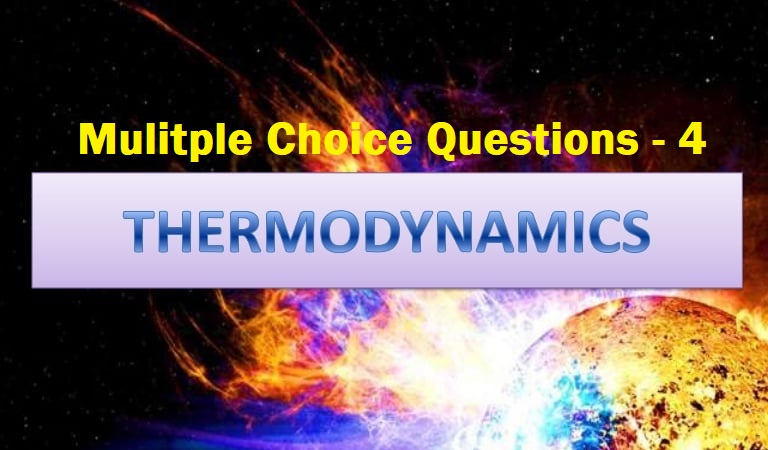CBSE Class 11 Chemistry Chapter 6 Thermodynamics Multiple Choice Questions with Answers. MCQ Questions Class 11 Chemistry Thermodynamics with Answers was Prepared Based on Latest Exam Pattern. Students can solve NCERT Class 11 Chemistry Thermodynamics MCQs with Answers to know their preparation level.
Students who are searching for NCERT MCQ Questions for Class 11 Chemistry Thermodynamics with Answers are compiled here to get good practice on all fundamentals. Know your preparation level on MCQ Questions for Class 11 Chemistry with Answers. You can also verify your answers from our provided MCQ Class 11 Chemistry Thermodynamics with Answers. So, ace up your preparation with MCQ of Chapter 6 Chemistry Objective Questions.
MCQ Questions Class 11 Chemistry Thermodynamics with Answers - Set - 4
Question 1:
The heats of combustion of graphite and CO respectively are -393.5 kj mol-1 and -283 kj mol-1. Therefore the heat of formation of CO in kj moj-1 is.
(a) +172.5
(b) -110.5
(c) -1070
(d) -676.5
(e) +110.5
Correct Answer – (B)
Question 2 :
In order to decompose 9 g water, 142.5 kj heat is required. Hence the enthalpy of formation of water is
(a) -196 kj mol-1
(b) +196 kj mol-1
(c) +948 kj mol-1
(d) -948 kj mol-1
Correct Answer – (B)
Question 3 :
Amount of heat required to change 1 g ice at 0°C to 1 g steam at 100°C is
(a) 616 cal
(b) 12 R cal
(c) 717 cal
(d) None of these
Correct Answer – (C)
Question 4 :
Which of the following reactions is endothermic?
(a) N2 + O2 → 2NO
(b) H2 + Cl2 → 2HCl
(c) H2SO4 + 2NaOH → Na2SO4 + 2H11O
(d) None of these
Correct Answer – (A)
Question 5 :
In which of the following process, the process is always non-feasible?
(a) ∆H > 0, ∆S > 0
(b) ∆H < 0, ∆S > 0
(c) ∆H > 0, ∆S < 0
(d) ∆H < 0, ∆S < 0
Correct Answer – (C)
MCQ Questions Class 11 Chemistry Thermodynamics with Answers
Question 6 :
Change in enthalpy for the reaction 2H2O2(l) → 2H2O(l) + O2(g) if the heat of formation of H2O2(l) and H2O(l) are – 188 kj mol-1 and -283 kj mol-1. Therefore the heat of formation of CO in kj mol-1 is
(a) +172.5
(b) -110.5
(c) -1070
(d) -676.5
(e) +110.5
Correct Answer – (A)
Question 7 :
In what proportional 1 M NaOH and 0.5 MH2SO4 are mixed respectively so as to release maximum amount of energy and to form 100 ml of solution?
(a) 33 and 67
(b) 67 and 33
(c) 40 and 60
(d) 50 and 50
Correct Answer – (D)
Question 8 :
An adiabatic’s expansion of an ideal gas always has
(a) Decrease in temperature
(b) q = 0
(c) W = 0
(d) ∆H = 0.
Correct Answer – (B)
Question 9 :
internal energy does not include
(a) Nuclear energy
(b) Vibrational energy
(c) Rotational energy
(d) Energy of gravitational pull
Correct Answer – (D)
Question 10 :
(a) ∆H < ∆E
(b) ∆H = ∆E
(c) ∆H > ∆E
(d) ∆H = ∆E + RT∆11
Correct Answer – (B)
- NCERT Solutions Class 11 Chemistry Chapter 1 : Some Basic Concepts of Chemistry
- NCERT Solutions Class 11 Chemistry Chapter 2 : Structure Of The Atom
- NCERT Solutions Class 11 Chemistry Chapter 3 : Classification of Elements and Periodicity in Properties
- NCERT Solutions Class 11 Chemistry Chapter 4 : Chemical Bonding and Molecular Structure
- NCERT Solutions Class 11 Chemistry Chapter 5 : States of Matter
- NCERT Solutions Class 11 Chemistry Chapter 6 : Thermodynamics
- NCERT Solutions Class 11 Chemistry Chapter 7 : Equilibrium
- NCERT Solutions Class 11 Chemistry Chapter 8 : Redox Reactions
- NCERT Solutions Class 11 Chemistry Chapter 9 : Hydrogen
- NCERT Solutions Class 11 Chemistry Chapter 10 : The s-Block Elements
- NCERT Solutions Class 11 Chemistry Chapter 11 : The p-Block Elements
- NCERT Solutions Class 11 Chemistry Chapter 12 : Organic Chemistry: Some Basic Principles and Techniques
- NCERT Solutions Class 11 Chemistry Chapter 13 : Hydrocarbons
- NCERT Solutions Class 11 Chemistry Chapter 14 : Environmental Chemistry



